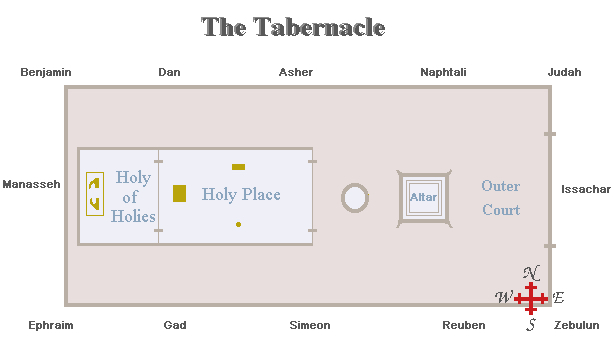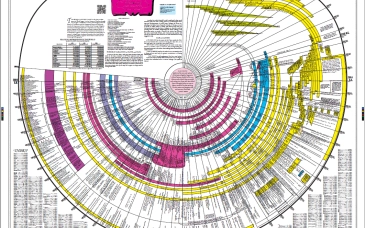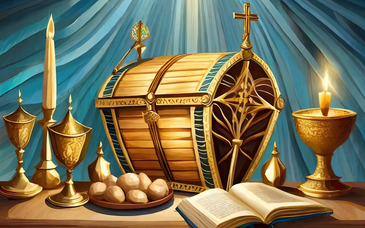History of Building the Tabernacle

God directed the people of Israel to construct a dwelling place for Himself in the midst of the people so they would know of his abiding presence and guidance. Moses was given the particulars on Mt. Sinai and construction began shortly after. Exodus 36:8ff; 40

Bezaleel and Aholiab were the chief constructors, and it is said that they and the other workmen were filled with the Sprit of God, in wisdom and in understanding to make all that God had commanded. The people so freely offered gifts and materials for the tabernacle, that they had to be restrained from bringing any more. The offerings were sufficient for all the work to make the Tabernacle, and more. Exodus 36:1
The list of materials included gold, silver and bronze. Material, yarn and woven linen of blue, purple and scarlet. Goats hair, ram's skin, goats skin, acacia wood, oil, spices, precious stones. There was embroidery and tapestry employed in the making of the curtains. Exodus 25, 35
The Tabernacle with all its furniture was brought to Moses when complete, and on the first day of the first month of the 2nd year he raised it up and finished the work. When the whole Tabernacle was assembled, the cloud covered the Tent of Meeting and the glory of the Lord filled the Tabernacle. Exodus 40:34 The cloud, which was the representation of the Divine Presence, had the appearance of a fire by night, and when it rose from or rested on the Tent, determined the movements and encampments of the children of Israel. Numbers 9:17
The Tabernacle accompanied the children of Israel during their wanderings in the desert, and in the different stages of the conquest of the land of Canaan. When the conquest was complete, the Tabernacle was permanently installed in Shiloh as the place which the Lord had chosen. Joshua 18:1 This is where it was found throughout Judges. At the time of the capture of the Ark God abandoned the Tabernacle of Shiloh. Psalm 78:60 The Ark never returned to the Tabernacle, and the Tabernacle was removed from Shiloh. We find it some years later with its priests and its table of Showbread at Nob. 1 Samuel 21:1 and in Solomon's time with its altar of burnt offering and ministered at by Zadok the high priest at Gibeon 1 Chronicles 16:39 After the building of the Temple it completely disappeared from history.
Area's of Worship

There were three areas of worship called the Outer Court, the Holy Place and the Holy of Holies.
The Outer Court
The outer court was open to all of Israel when they brought the proper sacrifices to worship. The dimensions were 100 cubit by 50 cubits, equivalent to about 150 X 74 feet. This rectangular shaped enclosure was really no part of the tabernacle proper but was rather a public meeting place which was fenced. It was always set up with large moveable pillars 5 cubits high joined by fancy rods over which were draped curtains made of a woven linen. In actual fact there were ten curtains each 28 cubits by four cubits made of fine twined linen, embroidered with figures of cherubim. The linen was coloured blue and purple and scarlet. The poles and pillars were decorated with silver and bronze. It was always set up pointing East and West with the entrance on the East side. Here was placed the altar of burnt offering and the laver or washing basin.
The Holy Place
The Holy Place was the area of the priests for the purpose of performing their daily duties. It differed from the outer court in that the walls were not cloth but wooden. Board covered on both sides with gold and held in place by rods to gave them support. The boards were 10 cubits high and 1.5 cubits wide. (The boards were narrower on the end corners to make up the exact measurement.) cubits.
The Holy of Holies
The Holy of Holies was only open to the High Priest once a year on the Day of Atonement when he made the atonement sacrifice for all of Israel. The structure of the Holy Place extended out to the west to include the Holy of Holies. It was built of the same material as the Holy Place. The two chambers were separated by the veil or curtain. This was no ordinary drape. It was more like a number of thick and heavy blankets sewn together and supported by four pillars of wood covered in gold and planted in silver sockets. Following the crucifixion when it is said that the veil in the temple was torn from top to bottom (not bottom to top) it indicates that this was clearly a divine action making access into the very presence of God now accessible to all who believe. Mark 16:38; Hebrews 10:19-25 The curtain not only kept out the people of God but also kept out the light. The candlesticks were only permitted in the Holy Place. The thick layers of curtain would have made it pitch black in the Holy of Holies. The way was illuminated by the shekinah glory of God's presence as he resided on his throne, the mercy seat, in the midst of His people.
Furniture of the Tabernacle
Outer Court Furniture - Brazen Altar

In the court yard outside the tent and in front of its door stood the Altar of burnt offering or what was sometimes called the brazen altar. It was a square box of five cubits and three cubits height. (7.5 ft. and 4.5 ft. High) The outside frame was made of acacia wood overlaid with brass. Exodus 27:1 The inside of the altar was probably filled with earth or stones. Exodus 20:24, 25 The altar had a ledge halfway up the inside which supported a grating of crafted brass. On each corner there was a horn which protruded which was used to bind the sacrifice to the altar. There were brass rings on the side and poles to carry it. There were also various bronze utensils used in the preparation of the sacrifices. A sacrifice of a lamb was offered here each morning and evening by the priests. The fire on this altar was to be perpetual and never go out. It symbolises the fact that God may be approached only by the way of sacrifice. Leviticus 17:11 It typifies the substitutionary death of Christ. Hebrews 8:3; 9:12

Outer Court Furniture - Laver

Between the brazen altar and the door of the Tent stood a laver of brass set on a base of brass. There may have been a lower basin for the washing of the feet which was part of the Laver. The women who worked about the Tabernacle contributed the bronze for overlaying on the laver. The priest must wash his hands and feet before he does any work in the tabernacle. Exodus 30:21 It symbolises the necessity of purity in approaching God. For the priests to fail to cleanse themselves was to mean certain death. The typology points to the washing of regeneration and sanctification in Christ. Titus 3:5; Hebrews 9:10
Holy Place Furniture - Table of Showbread

On the north side of the altar stood the table of Showbread made of acacia wood overlaid with gold and decorated with gold trim. It also had gold rings and gold poles used to carry it. There were also gold plates and dishes for the bread. Twelve cakes were placed on the table before the Lord. Twelve unleavened loaves or cakes made of fine flour were placed on the table weekly. They were placed in two rows or piles and frankincense was placed on each row. The bread was changed every Sabbath and the old loaves were eaten by the priests in a holy place. Leviticus 24:5,8
It represents the meal offering symbolising the consecration of the activities of life to God. The typology is found in closer fellowship with God, which is to be realised in the heavenly and future kingdom of God. It is brought to expression in our communion with God. Luke 14:15.
Holy Place Furniture - Lampstand

On the south side of the altar of incense stood the candlestick or lampstand. Exodus 26:35 The candlestick was overlaid with pure beaten gold. It was decorated with almonds and flowers which made it the most ornate of all the furnishings of the Tabernacle. The utensils such as the snuffers, oil vessels and dishes were all made of gold. There were six branches, three protruding arms from each side and seven lamps which burned pure olive oil. The people must bring a sacrifice of oil in order that the lamps might burn. The lampstand burned within the Holy Place to provide light. Leviticus 24:3

Aaron would lit the lamps in the evening and extinguish them in the morning. Exodus 30:8
It symbolises the perfection (7 lamps) with which God's Old Testament people must shine forth before Him as enabled by the oil of the Holy Spirit causing its light to shine in the darkness of this world. Zechariah 4:2-6 The shining forth indirectly results in the praise of God.
The typology can be found in the present day as light and truth that radiates from the heart of the consecrated Christian, through Jesus Christ. Matthew 5:14; John 8:12

Holy Place Furniture - Altar of Incense

In the middle of the Holy place before the veil stood the Altar of Incense. This was similar in construction to the Brazen Altar but smaller and overlaid with gold, instead of brass. It was one cubit square and two cubits height. The priest would place incense on this altar to burn as a sweet smelling offering to the Lord both morning and evening. The fire was taken from the bronze altar. No animal sacrifices were performed on this altar. Once a year on the Day of Atonement the blood of the sin offering was placed on the horns of the Altar. Exodus 30:10 This was in preparation for the priest entering into the Holy of Holies. The symbolical and typological meaning of the altar is to be found in the believer's communion with God in prayer. Psalm 14:1,2; Luke 1:10; Revelation 8:4
Holy of Holies Furniture - Veil
The veil was a large colourful curtain which separated the Holy Place from the Holy of Holies. It was made of blue, purple and scarlet and fine twined linen with cherubim worked through the material. It was hung by hooks on four poles of Acacia wood overlaid with gold and standing on four silver bases. The Ark was placed behind the curtain in the Holy of Holies. Exodus 26:31 The symbolic reference was that the way to God was not clear and accessible for all of God's people. Hebrews 9:8 The typology is the pointing to Christ who would remove the veil as He tore the veil in two from top to bottom making the way to God accessible through Christ as His very flesh is symbolical of the veil now. Matthew 27:51; Hebrews 10:20
Holy of Holies Furniture - Ark of the Covenant

The Holy of Holies only contained one piece of furniture, but this is not to imply that it was of little significance. The Ark of the Covenant or the Ark of the Testimony could be considered the most important piece of furniture which Israel possessed. It was an oblong box of acacia wood, 2.5 cubits long and 1.5 cubits wide and high. (3.75 ft X 2.25 ft) It was overlaid within and without with gold, and had a rim or edging of gold around its top. It had rings and poles to carry it, and the necessity of only carrying the ark was stressed by the fact that the poles never left the rings.
The ark served to hold the Testimony or two tablets of the Law or Decalogue Exodus 25:21, the pot of wilderness manna Exodus 16:33, and Aaron's rod that budded Numbers 17:7. Along side the ark was placed Moses' Book of the Law Hebrews 9:4 Deuteronomy 31:26. It was called the Ark of the Testament. Numbers 10:33 This was the place of God's Revelation to Israel. The remembrance of the Covenant with Israel is to be found in these three objects. On top of the Ark was placed the lid or Kapporeth: the mercy seat or atonement covering made of pure gold. This slab of solid gold was the altar on which the highest atonement known to the Jewish law was carried out. On it worship service sprinkled the blood of the sin offering on the Day of Atonement. Leviticus 16:14,15 The mercy seat was the place of the manifestation of God's glory. It was God's throne in Israel. 1 Samuel 4:4 God literally sat between the cherubim. At the ends of the Mercy Seat were placed two cherubim of hammered gold, spreading out their wings so as to cover the Mercy Seat and looking towards it. Exodus 25:10
The ark was not merely symbolical of the indwelling of God among Israel, but actually contained Him. The cloud of God's glory, the manifestation of God's presence, rested over the Ark of the Covenant. The Kapporeth or mercy seat sprinkled with the blood of sacrifice was the grace of God intervening between the holiness of God's presence in the cloud and the witness of man's sin in the law underneath the mercy seat.
The typology is found in God's presence in the believer's inward fellowship with the person of Christ again symbolised in the Lord's supper. 1 Corinthians 10:16 Also there is the type of the presence of God in heaven itself. Psalm 11:4 heaven was the pattern which the earthly tabernacle was copied. Hebrews 9:24
Moving the Tabernacle
When the cloud moved off the Tabernacle the people of Israel were to begin to move. Exodus 40:37; Numbers 9:17. A silver trumpet was sounded for the breaking of Camp. On this signal the priests took the veil of the holy place and covered the Ark of the Covenant and placed two other covering over it. Then all of the other pieces of furniture were covered and the tabernacle was disassembled and carried by specific tribes. Numbers 4:7
The Kohathites carried all the furniture which had poles. Numbers 4:1 The Gershonites carried the curtains which surrounded the Tabernacle, the tent and the brazen altar. Numbers 4:21 The Merarites carried the frames, bars, poles of the structure of the tabernacle. Numbers 4:29 The Levites marched in the centre of the camp with six tribes in front of them and six behind them. Numbers 2:17 No one was allowed to touch the holy things on strict punishment of death. Numbers 4:15



